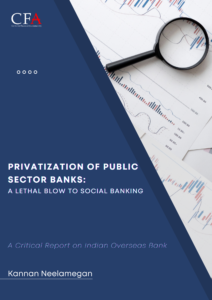A Critical Report on Indian Overseas Bank
 Today our country is in an economic crisis, mainly due to the COVID-19 pandemic. There is massive unemployment. Rural infrastructure is not improving, and the Central Government has been focusing on funding infrastructure projects and monetizing / privatizing public assets in order to fund such projects. Public Sector Banks have been a target of privatization moves for over three decades, but for the first time, the Government openly announced the privatization of two public sector banks in the budget speech of 2020.
Today our country is in an economic crisis, mainly due to the COVID-19 pandemic. There is massive unemployment. Rural infrastructure is not improving, and the Central Government has been focusing on funding infrastructure projects and monetizing / privatizing public assets in order to fund such projects. Public Sector Banks have been a target of privatization moves for over three decades, but for the first time, the Government openly announced the privatization of two public sector banks in the budget speech of 2020.
This paper specifically covers the initiatives taken by the Central Govt/Regulators on the Public Sector Banks as a whole, to which we feel that these issues are yet to be reviewed and immediately rectified. The recent proposal made by the government is a matter of serious concern that the Government is going to privatize two PSBs apart from continuing the unwanted mega-merger process. Since the announcement of privatisation of two public sector banks, there has been much talk about which would be the two banks to be privatized. Though there has not been any confirmation, it is widely believed that the Central Bank of India and Indian Overseas Bank have been zeroed down for privatization. This paper looks closely at IOB and its contributions.
The Pathway To Privatization:
Since the Narasimham committee which proposed the banking reforms in the 1990s had recommended the state to reduce its stakes in the public sector banks to 33 percent. Though direct privatization of disinvestment was strongly resisted by the people and unions, over the decades many measures were taken that have ultimately made it possible for privatization.
From reducing human resource by not filling permanent positions, introducing Voluntary retirement policies which have mostly drained out experienced senior officials, diversifying from banking services to offer other financial products like insurance etc are some of the measures that have weakened the banks from within. Changes in the lending patterns too have had their impacts on the banks. One of the objectives of nationalization was to ensure that credits reached common people for their credit needs, with the reversal of this policy banks entered into long-term lending ended with huge NPAs. All measure to address the NPA crisis has been a stepping stone towards privatization.
Through mergers, the number of PSBs has been reduced. The introduction of IBC also facilitated high provisions which reduced the profits of the PSBs. The formation of the National Asset Reconstruction Company enables the banks to sell their bad loans to the company to clean their balance sheet, which will surely aid in a better valuation.
The government also uses other methods to aid privatization by absorbing the risks like in the case of IDBI. When IDBI bank was facing the NPA crisis, it was made public sector in 2014. The government infused substantial capital needs and the bank also made huge write-offs under the PSB’s entity. When it started earning profits, once again it was privatized in 2019.
Read and download the resource here: Privatization of Public Sector Banks_A lethal blow to social banking
Centre for Financial Accountability is now on Telegram. Click here to join our Telegram channel and stay tuned to the latest updates and insights on the economy and finance.
